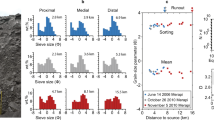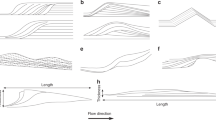Abstract
There is increasing evidence that fine-grained deposits of pyroclastic density currents can be remobilized on a large scale, resulting in concentrated flows. These flows can be a major hazard; for example, at Soufrière Hills Volcano (Montserrat) in 1997, some travelled beyond the designated danger zone to inhabited areas. Despite their hazard potential, the scale and generation mechanism of these flows are poorly understood. Here we demonstrate using laboratory experiments and numerical modelling that decompression following the passage of dilute pyroclastic density currents can cause rapid deposit fluidization over areas of several square kilometres and to depths of tens of centimetres. The fluidized volume can be substantially greater than that deposited by the triggering pyroclastic density current because of remobilization of previously emplaced deposits, and the fluidized volume can flow even on slopes of a few degrees. The capacity for remobilization of a deposit is limited by its particle cohesion, which rapidly increases with atmospheric humidity. This mechanism of fluidization should alert us to an under-appreciated volcanic hazard of long-run-out pyroclastic flows that can be generated by remobilization very rapidly and with little warning.
This is a preview of subscription content, access via your institution
Access options
Access Nature and 54 other Nature Portfolio journals
Get Nature+, our best-value online-access subscription
$29.99 / 30 days
cancel any time
Subscribe to this journal
Receive 12 print issues and online access
$259.00 per year
only $21.58 per issue
Buy this article
- Purchase on Springer Link
- Instant access to full article PDF
Prices may be subject to local taxes which are calculated during checkout




Similar content being viewed by others
Data availability
Videos and synchronized pressure data (text files) of characteristic experiments can be downloaded from https://doi.org/10.25519/TF5A-8291.
Code availability
The numerical code used (open source) is available at https://doi.org/10.25519/TF5A-8291. The estimation of the pressure and the decompression rate in the field has been done with the version ‘Pyroclastic flows and surges’ of VolcFlow, which is downloadable at https://lmv.uca.fr/volcflow/.
References
Sparks, R. S. J. & Walker, G. P. L. The ground surge deposit: a third type of pyroclastic rock. Nat. Phys. Sci. 241, 62–64 (1973).
Valentine, G. A. Stratified flow in pyroclastic surges. Bull. Volcanol. 49, 616–630 (1987).
Branney, M. & Kokelaar, P. Pyroclastic Density Currents and the Sedimentation of Ignimbrites. Geological Society Memoir No. 27 (Geological Society, 2002).
Dufek, J., Esposti Ongaro, T. & Roche, O. in The Encyclopedia of Volcanoes (ed. Sigurdsson, H.) Ch. 35 (Elsevier, 2015).
Andrews, B. J. & Manga, M. Experimental study of turbulence, sedimentation, and coignimbrite mass partitioning in dilute pyroclastic density currents. J. Volcanol. Geotherm. Res. 225, 30–44 (2012).
Breard, E. C. P. et al. Coupling of turbulent and non–turbulent flow regimes within pyroclastic density currents. Nat. Geosci. 9, 767–771 (2016).
Weit, A., Roche, O., Dubois, T. & Manga, M. Maximum solid phase concentration in geophysical turbulent gas‐particle flows: insights from laboratory experiments. Geophys. Res. Lett. 46, 6388–6396 (2019).
Yamamoto, T., Takarada, S. & Shigeru, S. Pyroclastic flows from the 1991 eruption of Unzen volcano, Japan. Bull. Volcanol. 55, 166–175 (1993).
Cole, P. D. et al. in The Eruption of Soufriere Hills Volcano, Montserrat, From 1995 to 1999. Geological Society Memoirs 21 (eds Druitt, T. H. & Kokelaar, B. P.) 231–262 (Geological Society, 2002).
Bourdier, J. L., Boudon, G. & Gourgaud, A. Stratigraphy of the 1920 and 1929 nuée-ardente deposits. Mt. Pelée, Martinique. J. Volcanol. Geotherm. Res. 38, 77–96 (1989).
Komorowski, J. C. et al. Paroxysmal dome explosion during the Merapi 2010 eruption: processes and facies relationships of associated high-energy pyroclastic density currents. J. Volcanol. Geotherm. Res. 261, 260–294 (2013).
Douillet, G. A. et al. Syn- eruptive, softsediment deformation of deposits from dilute pyroclastic density current: triggers from granular shear, dynamic pore pressure, ballistic impacts and shock waves. Solid Earth 6, 553–572 (2015).
Valentine, G. A., Fierstein, J. & White, J. D. L. Pyroclastic deposits of Ubehebe Crater, Death Valley, California, USA: ballistics, pyroclastic surges, and dry granular flows. Geosphere 18, 1926–1957 (2022).
Calder, E. S. et al. in The Eruption of Soufriere Hills Volcano, Montserrat, From 1995 to 1999. Geological Society Memoirs 21 (eds Druitt, T.H. & Kokelaar, B.P.) 173–190 (Geological Society, 2002).
Druitt, T. H. et al. in The Eruption of Soufriere Hills Volcano, Montserrat, From 1995 to 1999. Geological Society Memoirs 21 (eds Druitt, T.H. & Kokelaar, B.P.) 263–279 (Geological Society, 2007).
Fisher, R. V. Transport and deposition of a pyroclastic surge across an area of high relief: the 18 May 1980 eruption of Mount St. Helens, Washington. Geol. Soc. Am. Bull. 102, 1038–1054 (1990).
Hoblitt, R. P., Miller, D. C. & Vallance, J. E. in The 1980 Eruptions of Mount St. Helens, Washington. US Geological Survey Professional Papers 1250 (eds Lipman, P.W. & Mullineaux, D.R.) 379–400 (US Geological Survey, 1981).
Fisher, R. V., Smith, A. L. & Roobol, M. J. Destruction of St. Pierre, Martinique, by ash-cloud surges, May 8 and 20 1902. Geology 8, 472–476 (1980).
Valentine, G. A., Fierstein, J. & White, J. D. L. Soft sediment deformation in dry pyroclastic deposits at Ubehebe Crater, Death Valley, California. Geology 49, 211–215 (2021).
Ritchie, L. J., Cole, P. D. & Sparks, R. S. J. in The Eruption of Soufriere Hills Volcano, Montserrat, From 1995 to 1999. Geological Society Memoirs 21 (eds Druitt, T.H. & Kokelaar, B.P.) 435–456 (Geological Society, 2015).
Cummins, P. R. Irrigation and the Palu landslides. Nat. Geosci. 12, 881–882 (2019).
Bradley, K. et al. Earthquake-triggered 2018 Palu Valley landslides enabled by wet rice cultivation. Nat. Geosci. 12, 935–939 (2019).
Watkinson, I. M. & Hall, R. Impact of communal irrigation on the 2018 Palu earthquake-triggered landslides. Nat. Geosci. 12, 940–945 (2019).
Massey, C. et al. Landslides triggered by the 14 November 2016 Mw 7.8 Kaikōura earthquake, New Zealand. Bull. Seismol. Soc. Am. 108, 1630–1648 (2018).
Xu, C. et al. Landslides triggered by the 2016 Mj 7.3 Kumamoto, Japan, earthquake. Landslides 15, 551–564 (2018).
Ishihara, K. & Koga, Y. Case studies of liquefaction in the 1964 Niigata earthquake. Soils Found. 21, 35–52 (1981).
Yoshida, N. et al. Causes of Showa Bridge collapse in the 1964 Niigata earthquake based on eyewitness testimony. Soils Found. 47, 1075–1087 (2007).
Sparks, R. S. J. Particle size variations in ignimbrites and implications for the transport of pyroclastic flows. Sedimentology 23, 147–188 (1976).
Wilson, C. J. N. The role of fluidization in the emplacement of pyroclastic flows: an experimental approach. J. Volcanol. Geotherm. Res. 8, 231–249 (1980).
Druitt, T. H. Pyroclastic density currents. Geol. Soc. Lond. Spec. Publ. 145, 145–182 (1998).
Freundt, A. & Bursik, M. in From Magma to Tephra (eds Freundt A. & Rosi, M.) 173–245 (Elsevier, 2001).
Roche, O. Depositional processes and gas pore pressure in pyroclastic flows: an experimental perspective. Bull. Volcanol. 74, 1807–1820 (2012).
Gueugneau, V., Kelfoun, K., Roche, O. & Chupin, L. Effects of pore pressure in pyroclastic flows: numerical simulation and experimental validation. Geophys. Res. Lett. 44, 2194–2202 (2017).
Kelfoun, K. & Gueugneau, V. A unifying model for pyroclastic surge genesis and pyroclastic flow fluidization. Geophys. Res. Lett. 49, e2021GL096517 (2022).
Druitt, T. H., Avard, G., Bruni, G., Lettieri, P. & Maez, F. Gas retention in fine-grained pyroclastic flow materials at high temperatures. Bull. Volcanol. 69, 881–901 (2007).
Chedeville, C. & Roche, O. Autofluidization of collapsing bed of fine particles: implications for the emplacement of pyroclastic flows. J. Volcanol. Geotherm. Res. 368, 91–99 (2018).
Walker, G. P. Grain-size characteristics of pyroclastic deposits. J. Geol. 79, 696–714 (1971).
Breard, E. C. P. et al. The permeability of volcanic mixtures. Implications for pyroclastic currents. J. Geophys. Res. Solid Earth 124, 1343–1360 (2019).
Bareschino, P. et al. Fluidization and de-aeration of pyroclastic mixtures: the influence of fines content, polydispersity and shear flow. J. Volcanol. Geotherm. Res. 164, 284–292 (2007).
Kelfoun, K. et al. Simulation of block-and-ash flows and ash-cloud surges of the 2010 eruption of Merapi volcano with a two-layer model. J. Geophys. Res. Solid Earth 122, 4277–4292 (2017).
Gueugneau, V., Kelfoun, K. & Druitt, T. H. Investigation of surge-derived pyroclastic flow formation by numerical modelling of the 25 June 1997 dome collapse at Soufrière Hills Volcano, Montserrat. Bull. Volcanol. 81, 25 (2019).
Moore, J. G. & Rice, C. J. in Explosive Volcanism: Inception, Evolution and Hazards. 133–142 (National Academy of Sciences Press, 1984).
Syarifuddin, M. et al. Estimating the velocity of pyroclastic density currents using an operational dual-PRF radar. J. Volcanol. Geotherm. Res. 424, 107462 (2022).
Brosch, E. et al. Destructiveness of pyroclastic surges controlled by turbulent fluctuations. Nat. Commun. 12, 7306 (2021).
Geldart, D. Types of gas fluidisation. Powder Technol. 7, 285–292 (1973).
Acknowledgements
This is contribution number 590 of the ClerVolc programme of the International Research Center for Disaster Sciences and Sustainable Development of the University Clermont Auvergne. We thank T. Latchimy, E. Régis, E. Brut, J.-L. Fruquière and C. Guillot for their help in the construction of the experimental devices. The comments of G. Valentine contributed substantially to the improvement of the article.
Author information
Authors and Affiliations
Contributions
Conceptualization: K.K. Laboratory experiments: K.K. & A.P. Numerical code: K.K. Writing—original draft: K.K. and A.P. Writing—review and editing: K.K. Funding acquisition: K.K.
Corresponding author
Ethics declarations
Competing interests
The authors declare no competing interests.
Peer review
Peer review information
Nature Geoscience thanks Greg Valentine, Roberto Sulpizio and the other, anonymous, reviewer(s) for their contribution to the peer review of this work. Primary handling editor: Stefan Lachowycz, in collaboration with the Nature Geoscience team.
Additional information
Publisher’s note Springer Nature remains neutral with regard to jurisdictional claims in published maps and institutional affiliations.
Extended data
Extended Data Fig. 1 Numerical simulation of one laboratory experiment.
(a) Pressure evolution in the deposit for K = 2 × 10−12, 3 × 10−12 and 4 × 10−12 m2. The experimental measurements are given by the white circles. Where the particle pressure (red lines) is equal to or lower than the gas pressure, the granular material is fully fluidized locally. (b) Evolution of the apparent friction angle δ with time for K = 3 × 10−12 m2. During decompression, the flow is fully fluidized down to about 12 cm beneath the surface and the apparent friction angle of less than 10° shows that all the material can flow on steeper slopes for more than 1 s (and the upper surface for 4 s). Because the geometry change induced by the flow was not simulated, results are compared with experiments carried out on the horizontal but the time of fluidization coincides with the flow duration of experiments carried out on a slope and in the same conditions.
Extended Data Fig. 2 Evolution of the ratio Hf/H according to II1 and II2.
The colours give the values of Hf/H of each of the 5000 simulations used to draw the curves (some points overlap exactly). The data used to make the figure are available here: 10.25519/TF5A-8291. They have been made with the numerical code available in the same repository.
Rights and permissions
Springer Nature or its licensor (e.g. a society or other partner) holds exclusive rights to this article under a publishing agreement with the author(s) or other rightsholder(s); author self-archiving of the accepted manuscript version of this article is solely governed by the terms of such publishing agreement and applicable law.
About this article
Cite this article
Kelfoun, K., Proaño, A. Large-scale volcanic deposit fluidization by dilute pyroclastic density currents. Nat. Geosci. 16, 499–504 (2023). https://doi.org/10.1038/s41561-023-01190-7
Received:
Accepted:
Published:
Issue Date:
DOI: https://doi.org/10.1038/s41561-023-01190-7



